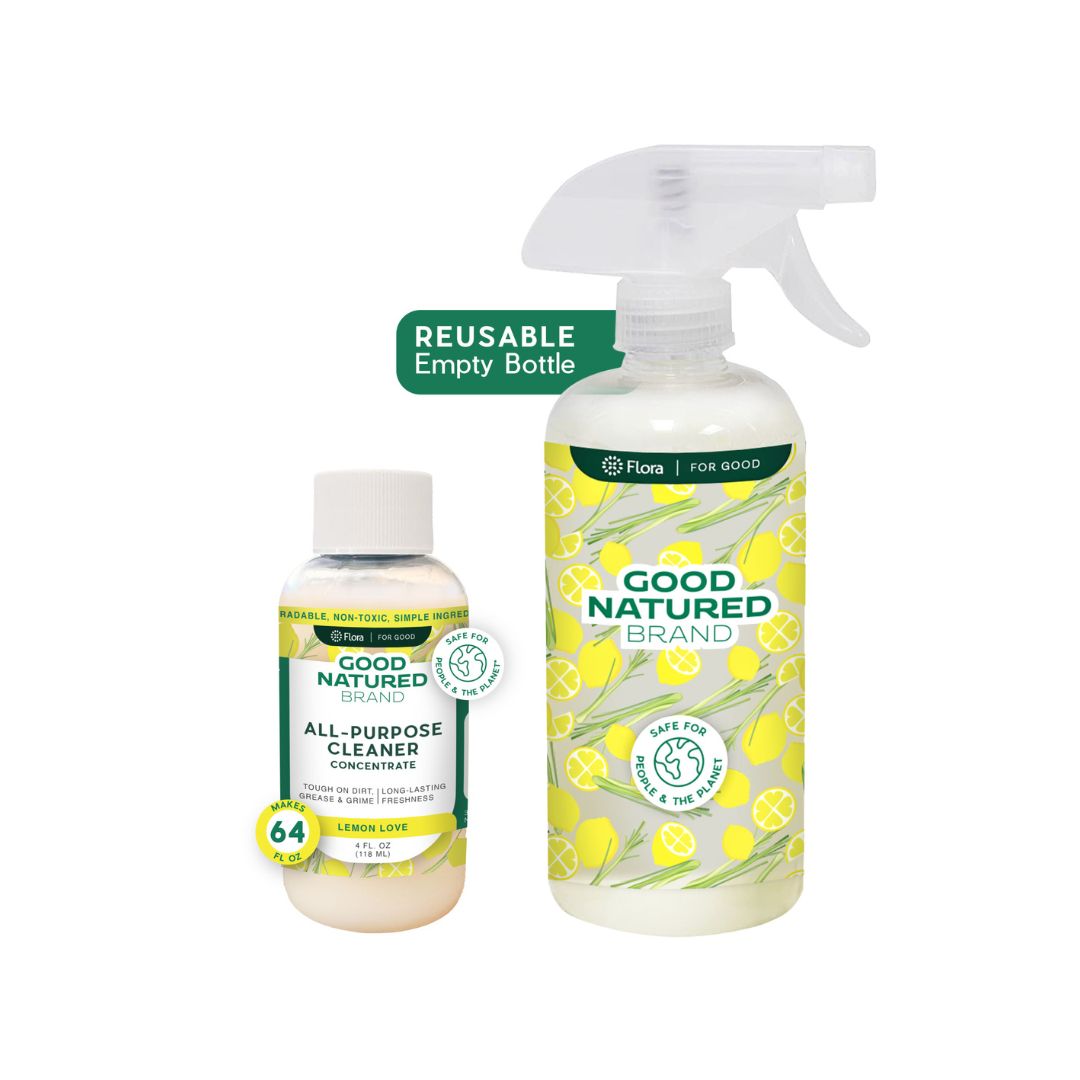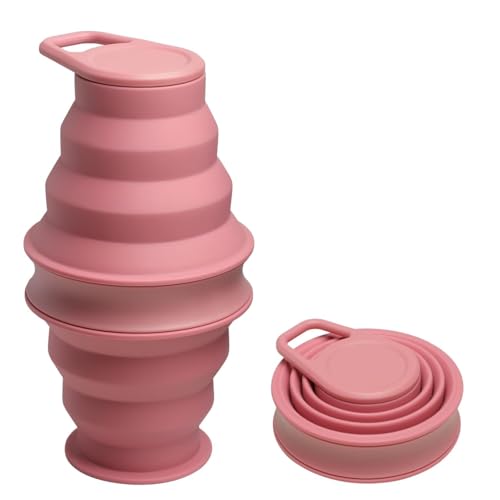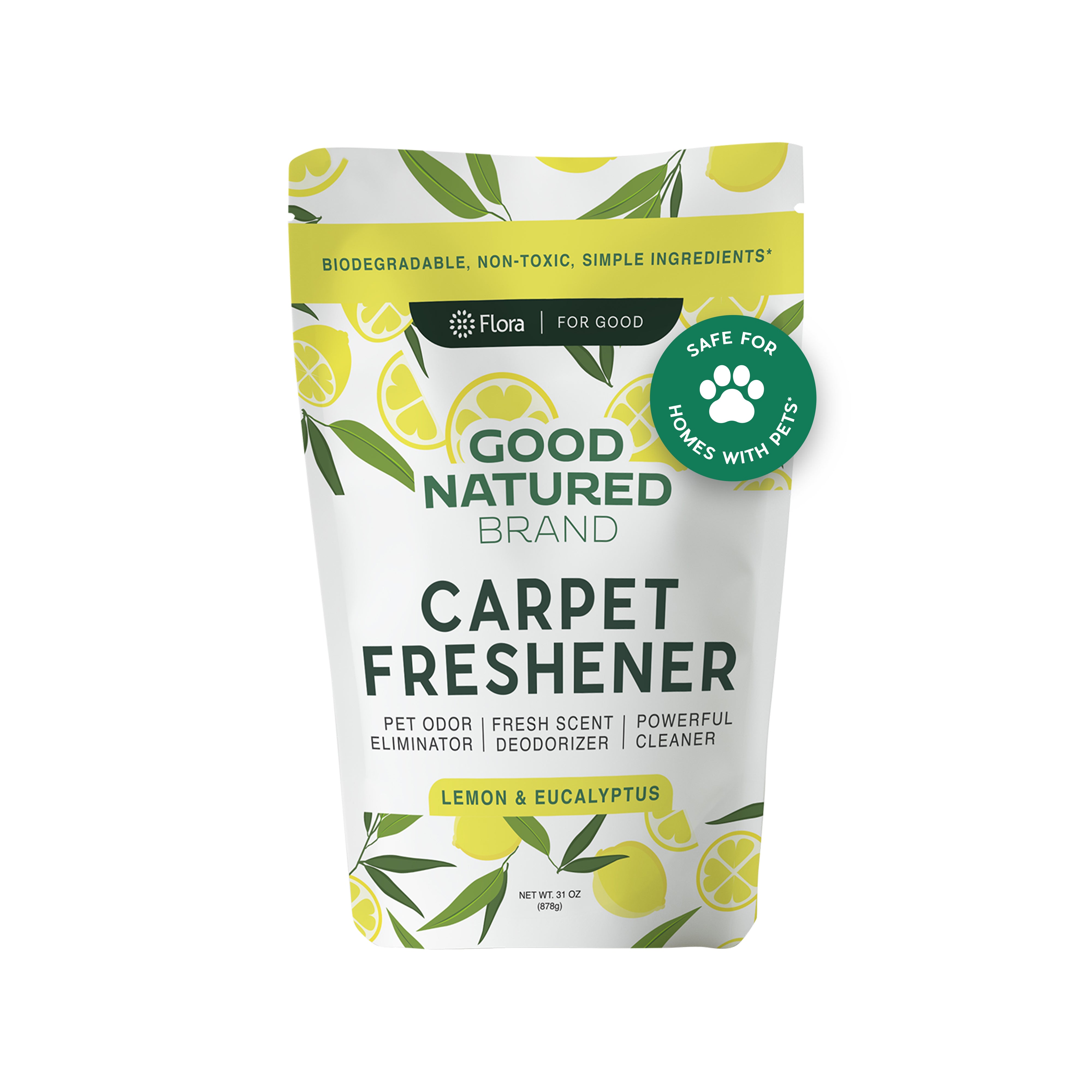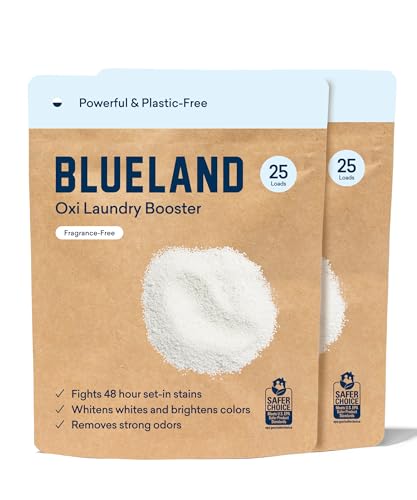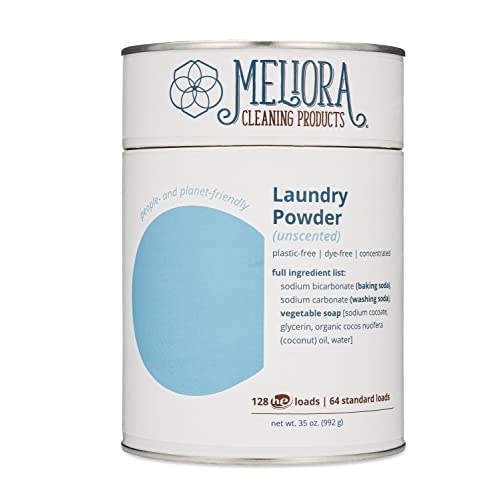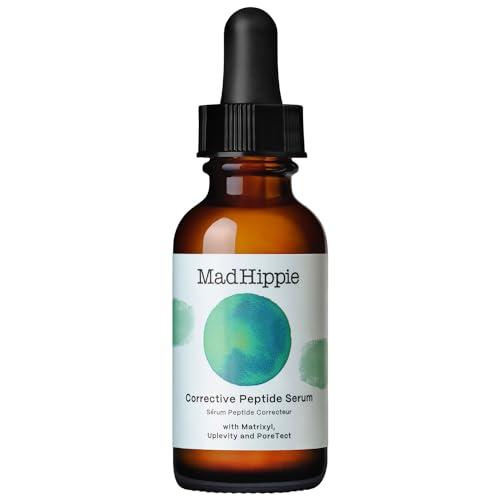
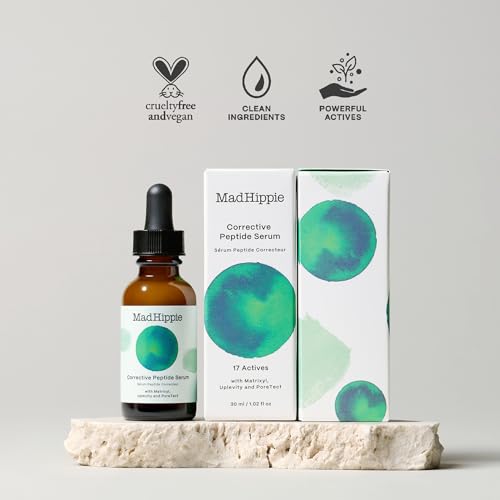
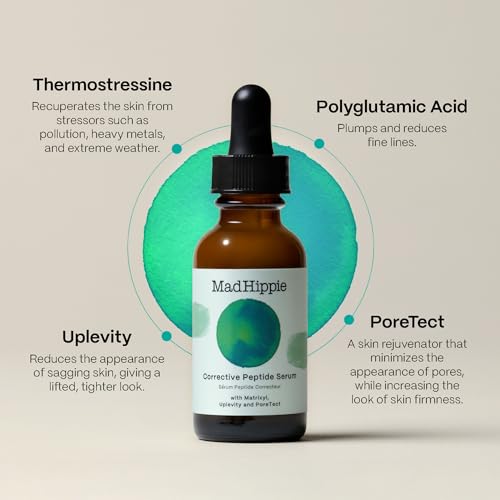
Mad Hippie Face Serum - Anti-Wrinkle, Hydrating Peptides, Nourishing Formula - 1.02 Fl Oz


Lecithin
Medium RiskLecithin is a naturally occurring lipid found in various plant and animal tissues, primarily composed of phospholipids. It serves as an emulsifier, stabilizing mixtures of oil and water, and is commonly used in food, cosmetics, and pharmaceuticals to improve texture and extend shelf life.
Sustai Insights
Lecithin provides functional benefits as an effective emulsifier and stabilizer, enhancing product texture while being sustainably sourced from natural origins. Health risks are generally low, with moderate concerns regarding allergies and immunotoxicity but minimal cancer or reproductive toxicity risks. Environmental hazards are limited, and it is not classified as a pollutant. Regulatory bodies impose few restrictions. Overall, lecithin presents a medium risk, suggesting caution in usage, especially for sensitive individuals. Alternatives include sunflower lecithin or other plant-based emulsifiers that may offer similar benefits with reduced allergenic potential.
Citrus Aurantium Dulcis (Orange) Peel Oil
Medium RiskCitrus aurantium dulcis (orange) peel oil is derived from the peel of oranges and is commonly used in cosmetic and personal care products for its fragrance and potential skin benefits. It is known for its aromatic properties and is often included in formulations aimed at enhancing scent profiles.
Sustai Insights
Citrus aurantium dulcis (orange) peel oil offers functional benefits such as providing a pleasant scent and potential antimicrobial properties. However, it poses a high allergy risk and may cause skin irritation in sensitive individuals. Environmental concerns include moderate persistence and potential to contribute to pollution. Regulatory warnings indicate restrictions on use in certain products. Overall, the risk level is assessed as medium, and users are advised to practice caution, particularly those with known allergies. Alternatives like sweet orange essential oil may provide similar benefits with potentially lower risks.
Phenethyl Alcohol
Medium RiskPhenethyl alcohol is an aromatic alcohol commonly used in cosmetic formulations. It functions primarily as a solvent and a preservative, contributing to product stability and enhancing the fragrance profile.
Sustai Insights
Phenethyl alcohol exhibits functional benefits as a preservative and solvent in cosmetic products, with some sustainability credentials due to its natural origin. However, it is associated with moderate allergy concerns and low risks of carcinogenicity and reproductive toxicity. Regulatory bodies have imposed specific use restrictions, highlighting the need for cautious application. Overall, the risk assessment indicates a medium risk level, warranting safe usage practices and consideration of alternatives like natural preservatives.
Propanediol
Low RiskPropanediol is a glycol compound commonly used in cosmetic and personal care products as a solvent, humectant, and skin-conditioning agent. It serves to enhance the texture and moisture retention of formulations, contributing to overall product efficacy.
Sustai Insights
Propanediol offers functional benefits such as effective moisture retention and improved product application. It is considered low-risk in terms of health concerns, with minimal associations with carcinogenicity, allergies, or reproductive toxicity. Environmentally, it has low pollutant potential and is not bioaccumulative. Regulatory bodies have not placed restrictions on its use. Despite concerns regarding enhanced skin absorption and potential endocrine disruption, the overall assessment indicates low risk. Safe usage practices should be followed, and alternatives like glycerin or other plant-based humectants can be considered.
Palmitoyl Tripeptide 38
Low RiskPalmitoyl tripeptide-38 is a synthetic peptide commonly used in cosmetic formulations, primarily for its role in promoting skin elasticity and reducing the appearance of wrinkles. It functions by stimulating the production of collagen and other essential skin components, contributing to improved skin texture and firmness.
Sustai Insights
Palmitoyl tripeptide-38 offers functional benefits as a skin conditioning agent, enhancing collagen synthesis for anti-aging effects. It has low health risks, with negligible concerns regarding carcinogenicity, allergies, and neurotoxicity. Environmentally, it poses minimal hazards and is not bioaccumulative. Currently, there are no regulatory restrictions on its use, supporting its favorable risk profile. Overall, it is considered low risk, making it a viable option in cosmetic applications. For those seeking alternatives, other peptides or natural extracts may offer similar benefits.
Avena Sativa (Oat) Meal Extract
Low RiskAvena sativa (oat) meal extract is an extract derived from oats, commonly used in cosmetic formulations for its soothing and moisturizing properties. It is known for its ability to enhance the texture of products and provide a gentle touch to the skin.
Sustai Insights
Avena sativa (oat) meal extract offers several functional benefits, including skin soothing and hydration, making it a popular choice in cosmetics. It is sustainably sourced and has a low environmental impact, posing minimal risks such as carcinogenicity or allergenic potential. Regulatory assessments indicate low concern for health risks, with no major restrictions noted. Overall, the ingredient is categorized as low risk, making it a safe option for various cosmetic applications.
Squalane Oil
Low RiskSqualane oil is a lightweight, colorless oil derived from olive or sugarcane that is commonly used in cosmetic formulations. It functions primarily as a moisturizer and emollient, enhancing skin hydration while imparting a silky texture to products. Squalane is also known for its stability and resistance to oxidation, making it a favored ingredient in skincare.
Sustai Insights
Squalane oil is recognized for its effective moisturizing properties and is sustainably sourced, often derived from olives or sugarcane, contributing to its eco-friendly profile. Health risks are minimal, with low concerns for carcinogenicity, allergies, or reproductive toxicity. Environmental impact is also low, as it is not known to bioaccumulate or pollute. Regulatory bodies have not placed restrictions on its use. Overall, the ingredient poses a low risk, making it a safe option in cosmetic products. Alternatives such as jojoba oil or other plant-based emulsifiers may offer similar benefits.
Vegetarian Glycerin
Low RiskVegetarian glycerin, also known as glycerol, is a colorless, odorless, and viscous liquid derived from plant sources. It is primarily used as a humectant, solvent, and emollient in various personal care products, helping to retain moisture and improve texture.
Sustai Insights
Vegetarian glycerin offers functional benefits as an effective humectant, promoting hydration and skin smoothness. It is biodegradable and typically sustainably sourced. Health risks associated with glycerin are low, with no significant concerns for carcinogenicity, allergens, or reproductive toxicity. Environmental risks are minimal, and it is not subject to major regulatory warnings. Overall, the risk level for this ingredient is low, making it a safe choice in formulations. Safe usage practices include ensuring proper concentrations in products, and alternatives such as propylene glycol exist but may have differing properties.
Sorbitan Trioleate
Low RiskSorbitan trioleate is a triester of oleic acid and sorbitol, commonly used as an emulsifier and stabilizer in cosmetic formulations. It helps to blend oil and water components, enhancing product texture and consistency. This ingredient is often found in creams, lotions, and other topical applications.
Sustai Insights
Sorbitan trioleate offers functional benefits as an effective emulsifier, contributing to product stability and texture. It poses low health risks, with minimal concerns related to carcinogenicity, allergies, and reproductive toxicity. Environmentally, it is not associated with significant pollution or bioaccumulation. Regulatory bodies have not placed restrictions on its use, supporting its safety profile. Overall, it can be considered a low-risk ingredient for cosmetic applications, with no significant adverse impacts identified.
Sodium Acetylhyaluronate
Low RiskSodium acetylhyaluronate is a sodium salt derivative of hyaluronic acid, commonly used in cosmetic formulations for its hydrating properties. It functions primarily as a humectant, attracting moisture to the skin and helping to maintain hydration levels in various personal care products.
Sustai Insights
Sodium acetylhyaluronate is recognized for its effective moisture-retaining properties, enhancing skin hydration and improving product texture. It has low health risks, with negligible concerns regarding carcinogenicity, allergies, or reproductive toxicity. Environmentally, it poses minimal risks and is not associated with significant pollution or bioaccumulation. Regulatory assessments indicate no current restrictions. Overall, it is considered low risk, making it a favorable ingredient in cosmetic formulations.
Acetyl Tetrapeptide 2
Low RiskAcetyl tetrapeptide-2 is a reaction product of acetylated amino acids, commonly used in cosmetic formulations for its role in enhancing skin appearance. It functions primarily as a skin conditioning agent, often aimed at promoting a more youthful appearance and improving skin tone.
Sustai Insights
Acetyl tetrapeptide-2 offers functional benefits as a skin conditioning agent, potentially enhancing the skin's appearance. It has low associated health risks, with minimal concerns regarding carcinogenicity, allergies, and reproductive toxicity. Environmentally, it does not pose significant risks regarding pollution or bioaccumulation. Regulatory bodies do not impose restrictions on its use. Overall, it is considered low risk, and no specific alternatives are noted, making it a stable ingredient in cosmetic applications.
Ceramide Np
Low RiskCeramide NP is a synthetic N-acylated phytosphingosine, primarily used in cosmetics for its role in enhancing skin barrier function and moisture retention. It is a type of ceramide, which is a vital component of the skin's lipid barrier, helping to maintain hydration and protect against environmental stressors.
Sustai Insights
Ceramide NP offers functional benefits as a skin-replenishing agent, effectively improving hydration and barrier integrity. It is considered low risk for health concerns such as cancer, allergies, and developmental toxicity. Environmentally, it poses minimal risks of pollution or bioaccumulation. Regulatory agencies do not impose significant restrictions on its use, affirming its overall safety. Safe usage involves standard cosmetic concentrations, with no significant adverse effects noted. Alternatives may include plant-derived ceramides. Overall, Ceramide NP is assessed to have a low risk.
Caprylyl Glycol
Low RiskCaprylyl glycol (1,2-octanediol) is a multifunctional cosmetic ingredient primarily used as a skin-conditioning agent and preservative. It is derived from caprylic acid, a fatty acid found in coconut oil, and is commonly included in personal care products for its moisturizing properties.
Sustai Insights
Caprylyl glycol offers functional benefits such as acting as an effective humectant and preservative, enhancing skin hydration and product stability. It is considered to have low health risks, with no significant concerns regarding carcinogenicity, allergies, or reproductive toxicity. Environmentally, it poses minimal risks, being non-bioaccumulative and not linked to pollution. Regulatory assessments affirm its safety, with no major advisories against its use. Overall, the ingredient is assessed to have a low risk, making it a suitable choice in cosmetic formulations.
Tremella Fuciformis Polysaccharide
Low RiskTremella fuciformis polysaccharide is a polysaccharide derived from the Tremella fuciformis mushroom, commonly used in cosmetic formulations for its thickening and moisturizing properties. It acts as a humectant, helping to retain moisture in the skin and improve the texture of products.
Sustai Insights
Tremella fuciformis polysaccharide offers functional benefits such as effective moisture retention and skin conditioning. It is considered biodegradable and sourced sustainably. Health risks are low, with minimal concerns regarding irritation or allergies, and it is not classified as a carcinogen or reproductive toxin. Environmental risks are also low, with no significant pollutant or bioaccumulation potential noted. Regulatory bodies have not imposed restrictions on its use, supporting its safety profile. Overall, the ingredient is assessed as low risk, with no specific safe usage practices required. Alternatives include other natural polysaccharides, though Tremella fuciformis polysaccharide is already a sustainable option.
Polyglucuronic Acid
Low RiskPolyglucuronic acid is a polymer of glucuronic acid, commonly utilized in various cosmetic and personal care formulations for its ability to enhance product stability and moisture retention. It is recognized for its role in improving the texture and feel of products.
Sustai Insights
Polyglucuronic acid offers functional benefits such as moisture retention and product stability, contributing positively to formulation performance. It is considered low risk in terms of health concerns, with no significant adverse effects reported by regulatory bodies. Environmental impact is minimal, with no evidence of bioaccumulation or pollution potential. As it is not subject to restrictions, the overall risk level is low. Safe usage practices involve following recommended concentrations, with no notable alternatives required due to its favorable profile.
Polyglutamic Acid
Low RiskPolyglutamic acid is a polymer of glutamic acid, commonly used in skincare products for its hydrating properties. It functions primarily as a humectant, attracting moisture to the skin and enhancing the overall texture and appearance of formulations.
Sustai Insights
Polyglutamic acid offers several functional benefits, including excellent moisture retention and skin hydration, making it a valuable ingredient in cosmetic formulations. It is biodegradable and can be sustainably sourced. Health risks associated with polyglutamic acid are low, with minimal concerns regarding carcinogenicity, allergenic potential, and reproductive toxicity. Environmental risks are also low, with no significant pollutant or bioaccumulation potential reported. Regulatory bodies have not issued advisories against its use, affirming its safety. Overall, the risk level for this ingredient is low, making it a suitable choice for various applications.
Cetyl Hydroxyethylcellulose
Low RiskCetyl hydroxyethylcellulose is an ether of cetyl alcohol and hydroxyethylcellulose, primarily used as a thickening agent, emulsifier, and stabilizer in cosmetic formulations. It enhances the texture and consistency of products, contributing to their application and performance.
Sustai Insights
Cetyl hydroxyethylcellulose offers functional benefits as a thickening agent, improving product texture without significant adverse effects. It is regarded as low risk for health concerns such as cancer, allergies, or developmental toxicity. Environmentally, it poses minimal risk as it is not bioaccumulative or a known pollutant. Regulatory reviews indicate no significant restrictions, supporting its safe use. Given the available data, the overall risk assessment is low. Usage should be within standard concentrations as typically applied in cosmetics, with no notable safer alternatives identified.
Hydrolyzed Yeast Extract
Low RiskHydrolyzed yeast extract is a hydrolysate of yeast proteins, obtained through enzymatic hydrolysis. It serves as a flavor enhancer and nutrient supplement in various food and cosmetic products, contributing to their overall sensory profile and nutritional content.
Sustai Insights
Hydrolyzed yeast extract provides functional benefits such as flavor enhancement and nutritional support, being sustainably sourced with low environmental impact. Health risks are minimal, categorized as low for carcinogenicity, allergies, and reproductive toxicity. Regulatory status shows no current restrictions, indicating safety in use. Overall, the risk level is low, and safe usage practices should be followed. Alternatives include plant-based flavor enhancers that may offer similar benefits.
Chenopodium Quinoa Seed Extract
Low RiskChenopodium quinoa seed extract is an extract derived from the seeds of the quinoa plant, primarily used in cosmetic and personal care products for its moisturizing and nourishing properties. It acts as a skin conditioning agent, enhancing the texture and hydration of formulations.
Sustai Insights
Chenopodium quinoa seed extract offers functional benefits as a skin conditioning agent and is sustainably sourced, contributing positively to product efficacy and environmental considerations. Health risks are minimal, with low concerns regarding carcinogenicity, allergies, and reproductive toxicity. Environmental impact assessments indicate it does not pose significant hazards. Regulatory bodies have not placed restrictions on this ingredient, confirming its safety profile. Overall, the risk associated with this ingredient is low, making it a favorable option in formulations.
Linum Usitatissimum (Flax) Seed Extract
Low RiskLinum usitatissimum (linseed) seed extract is derived from the seeds of the flax plant and is commonly used in cosmetic and personal care products for its emollient properties. It is known for providing hydration and is often included in formulations aimed at improving skin texture and appearance.
Sustai Insights
Linum usitatissimum seed extract offers functional benefits such as moisturizing and soothing effects on the skin, contributing to enhanced product efficacy. It is sourced sustainably and is biodegradable. Health risks associated with this ingredient are minimal, with low concerns for carcinogenicity, allergies, or reproductive toxicity. Environmental impact is low, with no significant pollutant or bioaccumulation concerns. Regulatory status indicates no restrictions, ensuring safe usage in products. Overall, the risk level of this ingredient is assessed as low, with no notable adverse effects reported.
Hydroxypropyl Cyclodextrin
Low RiskHydroxypropyl cyclodextrin is a propylene glycol derivative of cyclodextrin, commonly used in cosmetic formulations as a stabilizing and solubilizing agent. It helps enhance the delivery of active ingredients and improve product texture without altering the overall formulation significantly.
Sustai Insights
Hydroxypropyl cyclodextrin serves as an effective solubilizer and stabilizer in cosmetics, facilitating enhanced delivery of active ingredients. It is generally regarded as safe, with low concerns regarding carcinogenicity, allergies, and reproductive toxicity. Environmental impacts are minimal, as it does not exhibit significant pollutant potential or bioaccumulation. However, it is subject to usage restrictions in verified products. Overall, it presents a low risk, making it a suitable choice in cosmetic formulations.
Hydroxyethylcellulose
Low RiskHydroxyethylcellulose is a modified cellulose polymer used primarily as a thickening agent and stabilizer in various cosmetic and personal care products. It is soluble in water and helps to improve the texture and viscosity of formulations, enhancing their usability and performance.
Sustai Insights
Hydroxyethylcellulose offers functional benefits such as effective thickening and stabilization in formulations, contributing to product texture. It is generally considered low-risk in terms of health, with minimal concerns regarding carcinogenicity, allergens, or reproductive toxicity. Environmentally, it poses low risks and is not known to be bioaccumulative. Regulatory bodies have not imposed significant restrictions on its use. Safe practices include adhering to recommended concentrations, and while alternatives exist, hydroxyethylcellulose remains a low-risk ingredient overall.
Tocopherol, D Alpha
Low RiskTocopherol, specifically d-alpha tocopherol, is a naturally occurring form of Vitamin E. It is commonly used in cosmetic and personal care products primarily for its antioxidant properties, helping to protect formulations from oxidation and extend shelf life.
Sustai Insights
D-alpha tocopherol provides effective antioxidant benefits, contributing to product stability. It is sustainably sourced and generally regarded as safe, with low concerns regarding carcinogenicity, allergies, and reproductive toxicity. However, there are minor concerns about endocrine disruption. Regulatory bodies have not imposed significant restrictions, indicating low overall risk. Recommended usage practices include adhering to established safe concentration thresholds. Alternatives, such as other forms of Vitamin E or plant-based antioxidants, may also be considered.
Stearyl Alcohol
Low RiskStearyl alcohol is a compound produced from the hydrogenation of stearic acid, commonly used in cosmetic formulations as an emulsifier and thickening agent. It helps stabilize products by blending oil and water phases, enhancing texture and consistency.
Sustai Insights
Stearyl alcohol provides functional benefits as an emulsifier and stabilizer, contributing to improved product texture. It is generally regarded as safe with low concerns for cancer, allergies, and reproductive toxicity. However, it may cause moderate skin, eye, or respiratory irritation. Regulatory bodies do not impose significant restrictions, indicating a low overall risk. While it poses minimal health and environmental hazards, caution is advised for sensitive individuals. Alternatives like cetyl alcohol or plant-based emulsifiers may offer safer options for formulators.
Caprylic Triglyceride
Low RiskCaprylic triglyceride is an ester derived from coconut oil and glycerin, commonly used in cosmetic formulations as an emollient, stabilizer, and skin-conditioning agent. It helps to improve the texture and spreadability of products while providing a lightweight, non-greasy feel.
Sustai Insights
Caprylic triglyceride offers functional benefits such as enhanced skin moisturization and improved formulation stability. It is generally regarded as safe, with low concerns regarding carcinogenicity, allergenic potential, and reproductive toxicity. Environmental impact is minimal, with no significant pollutant or bioaccumulative properties identified. Regulatory bodies have not issued warnings or restrictions. Overall, the risk level is low, making it a suitable ingredient in cosmetic products. Safe usage practices include adhering to recommended concentrations, and while there are alternatives, caprylic triglyceride remains a reliable choice.
Potassium Cetyl Phosphate
Low RiskPotassium cetyl phosphate is a potassium salt derived from cetyl alcohol and phosphoric acid, primarily used as an emulsifier and stabilizer in cosmetic formulations. It aids in blending oil and water components, enhancing product texture and performance.
Sustai Insights
Potassium cetyl phosphate offers functional benefits as an effective emulsifier, contributing to product stability. It is considered low risk regarding health impacts, with minimal concerns related to cancer, allergies, or reproductive toxicity. Environmentally, it poses low hazards, and there are no significant regulatory restrictions. Safe usage practices should be observed to minimize skin irritation. Alternatives such as glyceryl stearate may provide similar emulsifying properties while enhancing sustainability credentials. Overall, the ingredient is assessed as low risk.
Water
Low RiskWater is a clear, colorless liquid essential for various biological processes. It serves as a solvent in formulations, facilitating the dissolution of other ingredients and enhancing product texture and application. Additionally, water plays a crucial role in hydration and is a key component in many cosmetic and personal care products.
Sustai Insights
Water is an effective solvent and hydrator, contributing to the texture and efficacy of formulations. It is biodegradable and generally regarded as safe, with low concerns regarding carcinogenicity, allergies, and reproductive toxicity. However, excessive water usage can lead to environmental concerns, particularly regarding resource depletion. Regulatory bodies do not impose restrictions on water use in cosmetics. Overall, the risks associated with water are low, making it a safe and essential ingredient.
Propanediol
Low RiskPropanediol is a glycol compound commonly used in cosmetic and personal care products as a solvent, humectant, and skin-conditioning agent. It serves to enhance the texture and moisture retention of formulations, contributing to overall product efficacy.
Sustai Insights
Propanediol offers functional benefits such as effective moisture retention and improved product application. It is considered low-risk in terms of health concerns, with minimal associations with carcinogenicity, allergies, or reproductive toxicity. Environmentally, it has low pollutant potential and is not bioaccumulative. Regulatory bodies have not placed restrictions on its use. Despite concerns regarding enhanced skin absorption and potential endocrine disruption, the overall assessment indicates low risk. Safe usage practices should be followed, and alternatives like glycerin or other plant-based humectants can be considered.
Palmitoyl Tripeptide 38
Low RiskPalmitoyl tripeptide-38 is a synthetic peptide commonly used in cosmetic formulations, primarily for its role in promoting skin elasticity and reducing the appearance of wrinkles. It functions by stimulating the production of collagen and other essential skin components, contributing to improved skin texture and firmness.
Sustai Insights
Palmitoyl tripeptide-38 offers functional benefits as a skin conditioning agent, enhancing collagen synthesis for anti-aging effects. It has low health risks, with negligible concerns regarding carcinogenicity, allergies, and neurotoxicity. Environmentally, it poses minimal hazards and is not bioaccumulative. Currently, there are no regulatory restrictions on its use, supporting its favorable risk profile. Overall, it is considered low risk, making it a viable option in cosmetic applications. For those seeking alternatives, other peptides or natural extracts may offer similar benefits.
Avena Sativa (Oat) Meal Extract
Low RiskAvena sativa (oat) meal extract is an extract derived from oats, commonly used in cosmetic formulations for its soothing and moisturizing properties. It is known for its ability to enhance the texture of products and provide a gentle touch to the skin.
Sustai Insights
Avena sativa (oat) meal extract offers several functional benefits, including skin soothing and hydration, making it a popular choice in cosmetics. It is sustainably sourced and has a low environmental impact, posing minimal risks such as carcinogenicity or allergenic potential. Regulatory assessments indicate low concern for health risks, with no major restrictions noted. Overall, the ingredient is categorized as low risk, making it a safe option for various cosmetic applications.
Squalane Oil
Low RiskSqualane oil is a lightweight, colorless oil derived from olive or sugarcane that is commonly used in cosmetic formulations. It functions primarily as a moisturizer and emollient, enhancing skin hydration while imparting a silky texture to products. Squalane is also known for its stability and resistance to oxidation, making it a favored ingredient in skincare.
Sustai Insights
Squalane oil is recognized for its effective moisturizing properties and is sustainably sourced, often derived from olives or sugarcane, contributing to its eco-friendly profile. Health risks are minimal, with low concerns for carcinogenicity, allergies, or reproductive toxicity. Environmental impact is also low, as it is not known to bioaccumulate or pollute. Regulatory bodies have not placed restrictions on its use. Overall, the ingredient poses a low risk, making it a safe option in cosmetic products. Alternatives such as jojoba oil or other plant-based emulsifiers may offer similar benefits.
Vegetarian Glycerin
Low RiskVegetarian glycerin, also known as glycerol, is a colorless, odorless, and viscous liquid derived from plant sources. It is primarily used as a humectant, solvent, and emollient in various personal care products, helping to retain moisture and improve texture.
Sustai Insights
Vegetarian glycerin offers functional benefits as an effective humectant, promoting hydration and skin smoothness. It is biodegradable and typically sustainably sourced. Health risks associated with glycerin are low, with no significant concerns for carcinogenicity, allergens, or reproductive toxicity. Environmental risks are minimal, and it is not subject to major regulatory warnings. Overall, the risk level for this ingredient is low, making it a safe choice in formulations. Safe usage practices include ensuring proper concentrations in products, and alternatives such as propylene glycol exist but may have differing properties.
Sorbitan Trioleate
Low RiskSorbitan trioleate is a triester of oleic acid and sorbitol, commonly used as an emulsifier and stabilizer in cosmetic formulations. It helps to blend oil and water components, enhancing product texture and consistency. This ingredient is often found in creams, lotions, and other topical applications.
Sustai Insights
Sorbitan trioleate offers functional benefits as an effective emulsifier, contributing to product stability and texture. It poses low health risks, with minimal concerns related to carcinogenicity, allergies, and reproductive toxicity. Environmentally, it is not associated with significant pollution or bioaccumulation. Regulatory bodies have not placed restrictions on its use, supporting its safety profile. Overall, it can be considered a low-risk ingredient for cosmetic applications, with no significant adverse impacts identified.
Sodium Acetylhyaluronate
Low RiskSodium acetylhyaluronate is a sodium salt derivative of hyaluronic acid, commonly used in cosmetic formulations for its hydrating properties. It functions primarily as a humectant, attracting moisture to the skin and helping to maintain hydration levels in various personal care products.
Sustai Insights
Sodium acetylhyaluronate is recognized for its effective moisture-retaining properties, enhancing skin hydration and improving product texture. It has low health risks, with negligible concerns regarding carcinogenicity, allergies, or reproductive toxicity. Environmentally, it poses minimal risks and is not associated with significant pollution or bioaccumulation. Regulatory assessments indicate no current restrictions. Overall, it is considered low risk, making it a favorable ingredient in cosmetic formulations.
Acetyl Tetrapeptide 2
Low RiskAcetyl tetrapeptide-2 is a reaction product of acetylated amino acids, commonly used in cosmetic formulations for its role in enhancing skin appearance. It functions primarily as a skin conditioning agent, often aimed at promoting a more youthful appearance and improving skin tone.
Sustai Insights
Acetyl tetrapeptide-2 offers functional benefits as a skin conditioning agent, potentially enhancing the skin's appearance. It has low associated health risks, with minimal concerns regarding carcinogenicity, allergies, and reproductive toxicity. Environmentally, it does not pose significant risks regarding pollution or bioaccumulation. Regulatory bodies do not impose restrictions on its use. Overall, it is considered low risk, and no specific alternatives are noted, making it a stable ingredient in cosmetic applications.
Lecithin
Medium RiskLecithin is a naturally occurring lipid found in various plant and animal tissues, primarily composed of phospholipids. It serves as an emulsifier, stabilizing mixtures of oil and water, and is commonly used in food, cosmetics, and pharmaceuticals to improve texture and extend shelf life.
Sustai Insights
Lecithin provides functional benefits as an effective emulsifier and stabilizer, enhancing product texture while being sustainably sourced from natural origins. Health risks are generally low, with moderate concerns regarding allergies and immunotoxicity but minimal cancer or reproductive toxicity risks. Environmental hazards are limited, and it is not classified as a pollutant. Regulatory bodies impose few restrictions. Overall, lecithin presents a medium risk, suggesting caution in usage, especially for sensitive individuals. Alternatives include sunflower lecithin or other plant-based emulsifiers that may offer similar benefits with reduced allergenic potential.
Ceramide Np
Low RiskCeramide NP is a synthetic N-acylated phytosphingosine, primarily used in cosmetics for its role in enhancing skin barrier function and moisture retention. It is a type of ceramide, which is a vital component of the skin's lipid barrier, helping to maintain hydration and protect against environmental stressors.
Sustai Insights
Ceramide NP offers functional benefits as a skin-replenishing agent, effectively improving hydration and barrier integrity. It is considered low risk for health concerns such as cancer, allergies, and developmental toxicity. Environmentally, it poses minimal risks of pollution or bioaccumulation. Regulatory agencies do not impose significant restrictions on its use, affirming its overall safety. Safe usage involves standard cosmetic concentrations, with no significant adverse effects noted. Alternatives may include plant-derived ceramides. Overall, Ceramide NP is assessed to have a low risk.
Citrus Aurantium Dulcis (Orange) Peel Oil
Medium RiskCitrus aurantium dulcis (orange) peel oil is derived from the peel of oranges and is commonly used in cosmetic and personal care products for its fragrance and potential skin benefits. It is known for its aromatic properties and is often included in formulations aimed at enhancing scent profiles.
Sustai Insights
Citrus aurantium dulcis (orange) peel oil offers functional benefits such as providing a pleasant scent and potential antimicrobial properties. However, it poses a high allergy risk and may cause skin irritation in sensitive individuals. Environmental concerns include moderate persistence and potential to contribute to pollution. Regulatory warnings indicate restrictions on use in certain products. Overall, the risk level is assessed as medium, and users are advised to practice caution, particularly those with known allergies. Alternatives like sweet orange essential oil may provide similar benefits with potentially lower risks.
Caprylyl Glycol
Low RiskCaprylyl glycol (1,2-octanediol) is a multifunctional cosmetic ingredient primarily used as a skin-conditioning agent and preservative. It is derived from caprylic acid, a fatty acid found in coconut oil, and is commonly included in personal care products for its moisturizing properties.
Sustai Insights
Caprylyl glycol offers functional benefits such as acting as an effective humectant and preservative, enhancing skin hydration and product stability. It is considered to have low health risks, with no significant concerns regarding carcinogenicity, allergies, or reproductive toxicity. Environmentally, it poses minimal risks, being non-bioaccumulative and not linked to pollution. Regulatory assessments affirm its safety, with no major advisories against its use. Overall, the ingredient is assessed to have a low risk, making it a suitable choice in cosmetic formulations.
Tremella Fuciformis Polysaccharide
Low RiskTremella fuciformis polysaccharide is a polysaccharide derived from the Tremella fuciformis mushroom, commonly used in cosmetic formulations for its thickening and moisturizing properties. It acts as a humectant, helping to retain moisture in the skin and improve the texture of products.
Sustai Insights
Tremella fuciformis polysaccharide offers functional benefits such as effective moisture retention and skin conditioning. It is considered biodegradable and sourced sustainably. Health risks are low, with minimal concerns regarding irritation or allergies, and it is not classified as a carcinogen or reproductive toxin. Environmental risks are also low, with no significant pollutant or bioaccumulation potential noted. Regulatory bodies have not imposed restrictions on its use, supporting its safety profile. Overall, the ingredient is assessed as low risk, with no specific safe usage practices required. Alternatives include other natural polysaccharides, though Tremella fuciformis polysaccharide is already a sustainable option.
Polyglucuronic Acid
Low RiskPolyglucuronic acid is a polymer of glucuronic acid, commonly utilized in various cosmetic and personal care formulations for its ability to enhance product stability and moisture retention. It is recognized for its role in improving the texture and feel of products.
Sustai Insights
Polyglucuronic acid offers functional benefits such as moisture retention and product stability, contributing positively to formulation performance. It is considered low risk in terms of health concerns, with no significant adverse effects reported by regulatory bodies. Environmental impact is minimal, with no evidence of bioaccumulation or pollution potential. As it is not subject to restrictions, the overall risk level is low. Safe usage practices involve following recommended concentrations, with no notable alternatives required due to its favorable profile.
Polyglutamic Acid
Low RiskPolyglutamic acid is a polymer of glutamic acid, commonly used in skincare products for its hydrating properties. It functions primarily as a humectant, attracting moisture to the skin and enhancing the overall texture and appearance of formulations.
Sustai Insights
Polyglutamic acid offers several functional benefits, including excellent moisture retention and skin hydration, making it a valuable ingredient in cosmetic formulations. It is biodegradable and can be sustainably sourced. Health risks associated with polyglutamic acid are low, with minimal concerns regarding carcinogenicity, allergenic potential, and reproductive toxicity. Environmental risks are also low, with no significant pollutant or bioaccumulation potential reported. Regulatory bodies have not issued advisories against its use, affirming its safety. Overall, the risk level for this ingredient is low, making it a suitable choice for various applications.
Cetyl Hydroxyethylcellulose
Low RiskCetyl hydroxyethylcellulose is an ether of cetyl alcohol and hydroxyethylcellulose, primarily used as a thickening agent, emulsifier, and stabilizer in cosmetic formulations. It enhances the texture and consistency of products, contributing to their application and performance.
Sustai Insights
Cetyl hydroxyethylcellulose offers functional benefits as a thickening agent, improving product texture without significant adverse effects. It is regarded as low risk for health concerns such as cancer, allergies, or developmental toxicity. Environmentally, it poses minimal risk as it is not bioaccumulative or a known pollutant. Regulatory reviews indicate no significant restrictions, supporting its safe use. Given the available data, the overall risk assessment is low. Usage should be within standard concentrations as typically applied in cosmetics, with no notable safer alternatives identified.
Hydrolyzed Yeast Extract
Low RiskHydrolyzed yeast extract is a hydrolysate of yeast proteins, obtained through enzymatic hydrolysis. It serves as a flavor enhancer and nutrient supplement in various food and cosmetic products, contributing to their overall sensory profile and nutritional content.
Sustai Insights
Hydrolyzed yeast extract provides functional benefits such as flavor enhancement and nutritional support, being sustainably sourced with low environmental impact. Health risks are minimal, categorized as low for carcinogenicity, allergies, and reproductive toxicity. Regulatory status shows no current restrictions, indicating safety in use. Overall, the risk level is low, and safe usage practices should be followed. Alternatives include plant-based flavor enhancers that may offer similar benefits.
Chenopodium Quinoa Seed Extract
Low RiskChenopodium quinoa seed extract is an extract derived from the seeds of the quinoa plant, primarily used in cosmetic and personal care products for its moisturizing and nourishing properties. It acts as a skin conditioning agent, enhancing the texture and hydration of formulations.
Sustai Insights
Chenopodium quinoa seed extract offers functional benefits as a skin conditioning agent and is sustainably sourced, contributing positively to product efficacy and environmental considerations. Health risks are minimal, with low concerns regarding carcinogenicity, allergies, and reproductive toxicity. Environmental impact assessments indicate it does not pose significant hazards. Regulatory bodies have not placed restrictions on this ingredient, confirming its safety profile. Overall, the risk associated with this ingredient is low, making it a favorable option in formulations.
Linum Usitatissimum (Flax) Seed Extract
Low RiskLinum usitatissimum (linseed) seed extract is derived from the seeds of the flax plant and is commonly used in cosmetic and personal care products for its emollient properties. It is known for providing hydration and is often included in formulations aimed at improving skin texture and appearance.
Sustai Insights
Linum usitatissimum seed extract offers functional benefits such as moisturizing and soothing effects on the skin, contributing to enhanced product efficacy. It is sourced sustainably and is biodegradable. Health risks associated with this ingredient are minimal, with low concerns for carcinogenicity, allergies, or reproductive toxicity. Environmental impact is low, with no significant pollutant or bioaccumulation concerns. Regulatory status indicates no restrictions, ensuring safe usage in products. Overall, the risk level of this ingredient is assessed as low, with no notable adverse effects reported.
Hydroxypropyl Cyclodextrin
Low RiskHydroxypropyl cyclodextrin is a propylene glycol derivative of cyclodextrin, commonly used in cosmetic formulations as a stabilizing and solubilizing agent. It helps enhance the delivery of active ingredients and improve product texture without altering the overall formulation significantly.
Sustai Insights
Hydroxypropyl cyclodextrin serves as an effective solubilizer and stabilizer in cosmetics, facilitating enhanced delivery of active ingredients. It is generally regarded as safe, with low concerns regarding carcinogenicity, allergies, and reproductive toxicity. Environmental impacts are minimal, as it does not exhibit significant pollutant potential or bioaccumulation. However, it is subject to usage restrictions in verified products. Overall, it presents a low risk, making it a suitable choice in cosmetic formulations.
Phenethyl Alcohol
Medium RiskPhenethyl alcohol is an aromatic alcohol commonly used in cosmetic formulations. It functions primarily as a solvent and a preservative, contributing to product stability and enhancing the fragrance profile.
Sustai Insights
Phenethyl alcohol exhibits functional benefits as a preservative and solvent in cosmetic products, with some sustainability credentials due to its natural origin. However, it is associated with moderate allergy concerns and low risks of carcinogenicity and reproductive toxicity. Regulatory bodies have imposed specific use restrictions, highlighting the need for cautious application. Overall, the risk assessment indicates a medium risk level, warranting safe usage practices and consideration of alternatives like natural preservatives.
Hydroxyethylcellulose
Low RiskHydroxyethylcellulose is a modified cellulose polymer used primarily as a thickening agent and stabilizer in various cosmetic and personal care products. It is soluble in water and helps to improve the texture and viscosity of formulations, enhancing their usability and performance.
Sustai Insights
Hydroxyethylcellulose offers functional benefits such as effective thickening and stabilization in formulations, contributing to product texture. It is generally considered low-risk in terms of health, with minimal concerns regarding carcinogenicity, allergens, or reproductive toxicity. Environmentally, it poses low risks and is not known to be bioaccumulative. Regulatory bodies have not imposed significant restrictions on its use. Safe practices include adhering to recommended concentrations, and while alternatives exist, hydroxyethylcellulose remains a low-risk ingredient overall.
Tocopherol, D Alpha
Low RiskTocopherol, specifically d-alpha tocopherol, is a naturally occurring form of Vitamin E. It is commonly used in cosmetic and personal care products primarily for its antioxidant properties, helping to protect formulations from oxidation and extend shelf life.
Sustai Insights
D-alpha tocopherol provides effective antioxidant benefits, contributing to product stability. It is sustainably sourced and generally regarded as safe, with low concerns regarding carcinogenicity, allergies, and reproductive toxicity. However, there are minor concerns about endocrine disruption. Regulatory bodies have not imposed significant restrictions, indicating low overall risk. Recommended usage practices include adhering to established safe concentration thresholds. Alternatives, such as other forms of Vitamin E or plant-based antioxidants, may also be considered.
Stearyl Alcohol
Low RiskStearyl alcohol is a compound produced from the hydrogenation of stearic acid, commonly used in cosmetic formulations as an emulsifier and thickening agent. It helps stabilize products by blending oil and water phases, enhancing texture and consistency.
Sustai Insights
Stearyl alcohol provides functional benefits as an emulsifier and stabilizer, contributing to improved product texture. It is generally regarded as safe with low concerns for cancer, allergies, and reproductive toxicity. However, it may cause moderate skin, eye, or respiratory irritation. Regulatory bodies do not impose significant restrictions, indicating a low overall risk. While it poses minimal health and environmental hazards, caution is advised for sensitive individuals. Alternatives like cetyl alcohol or plant-based emulsifiers may offer safer options for formulators.
Caprylic Triglyceride
Low RiskCaprylic triglyceride is an ester derived from coconut oil and glycerin, commonly used in cosmetic formulations as an emollient, stabilizer, and skin-conditioning agent. It helps to improve the texture and spreadability of products while providing a lightweight, non-greasy feel.
Sustai Insights
Caprylic triglyceride offers functional benefits such as enhanced skin moisturization and improved formulation stability. It is generally regarded as safe, with low concerns regarding carcinogenicity, allergenic potential, and reproductive toxicity. Environmental impact is minimal, with no significant pollutant or bioaccumulative properties identified. Regulatory bodies have not issued warnings or restrictions. Overall, the risk level is low, making it a suitable ingredient in cosmetic products. Safe usage practices include adhering to recommended concentrations, and while there are alternatives, caprylic triglyceride remains a reliable choice.
Potassium Cetyl Phosphate
Low RiskPotassium cetyl phosphate is a potassium salt derived from cetyl alcohol and phosphoric acid, primarily used as an emulsifier and stabilizer in cosmetic formulations. It aids in blending oil and water components, enhancing product texture and performance.
Sustai Insights
Potassium cetyl phosphate offers functional benefits as an effective emulsifier, contributing to product stability. It is considered low risk regarding health impacts, with minimal concerns related to cancer, allergies, or reproductive toxicity. Environmentally, it poses low hazards, and there are no significant regulatory restrictions. Safe usage practices should be observed to minimize skin irritation. Alternatives such as glyceryl stearate may provide similar emulsifying properties while enhancing sustainability credentials. Overall, the ingredient is assessed as low risk.
Water
Low RiskWater is a clear, colorless liquid essential for various biological processes. It serves as a solvent in formulations, facilitating the dissolution of other ingredients and enhancing product texture and application. Additionally, water plays a crucial role in hydration and is a key component in many cosmetic and personal care products.
Sustai Insights
Water is an effective solvent and hydrator, contributing to the texture and efficacy of formulations. It is biodegradable and generally regarded as safe, with low concerns regarding carcinogenicity, allergies, and reproductive toxicity. However, excessive water usage can lead to environmental concerns, particularly regarding resource depletion. Regulatory bodies do not impose restrictions on water use in cosmetics. Overall, the risks associated with water are low, making it a safe and essential ingredient.
Discover the transformative power of Mad Hippie Corrective Peptide Serum, a rejuvenating formula designed to hydrate, nourish, and uplift aging skin. This anti-wrinkle serum is perfect for both men and women seeking a youthful glow.
- Hydrating Anti-Aging Formula: Enriched with polyglutamic acid and ceramide NP, this serum effectively retains moisture, helping to plump and rejuvenate sagging skin.
- Wrinkle-Smoothing Action: Targets environmental stressors and pollutants, promoting skin firmness and elasticity, making it an essential part of your anti-aging routine.
- Natural Ingredients: Formulated with cruelty-free, vegan, and fragrance-free ingredients, it reflects a commitment to sustainability and health.
- Versatile Use: Perfectly complements the Mad Hippie Face Cream and other serums, enhancing your overall skincare regimen for brighter, healthier skin.
- Customer-Focused Care: Join a community that values transparency and ethical practices, ensuring you make an informed choice for your skin and the planet.
Subscribe & Save with Sustai
- Best Price Guarantee: Always enjoy the lowest prices on sustainable home essentials.
- No Surprises: We’ll notify you before shipping. No hidden fees, ever.
- You’re in Charge: Change, pause, or cancel your subscription anytime with ease.
- Eco-Friendly Deliveries: Our grouped shipments mean less packaging and lower emissions.
Join us on a sustainable journey. Special offers for a limited time! Prices and promotions may change.
Recommended Products
Discover the transformative power of Mad Hippie Corrective Peptide Serum, a rejuvenating formula designed to hydrate, nourish, and uplift aging skin. This anti-wrinkle serum is perfect for both men and women seeking a youthful glow.
- Hydrating Anti-Aging Formula: Enriched with polyglutamic acid and ceramide NP, this serum effectively retains moisture, helping to plump and rejuvenate sagging skin.
- Wrinkle-Smoothing Action: Targets environmental stressors and pollutants, promoting skin firmness and elasticity, making it an essential part of your anti-aging routine.
- Natural Ingredients: Formulated with cruelty-free, vegan, and fragrance-free ingredients, it reflects a commitment to sustainability and health.
- Versatile Use: Perfectly complements the Mad Hippie Face Cream and other serums, enhancing your overall skincare regimen for brighter, healthier skin.
- Customer-Focused Care: Join a community that values transparency and ethical practices, ensuring you make an informed choice for your skin and the planet.

You can have at most 2 Sustainable Steals products in your cart
Customer Reviews
Customers’ View
Customers appreciate the effectiveness and eco-friendly nature of the Facial Serum. Common praises highlight its ability to enhance skin softness and clarity, with many users noting that it leaves their skin feeling smooth and hydrated. The pleasant scent of the serum also receives positive remarks, with customers describing it as clean and appealing. Additionally, users feel the product offers good value for money, often stating that its moderate price is justified by the visible improvements in their skin. Many customers also value the natural ingredients and cruelty-free formulation, reinforcing their commitment to environmentally conscious choices. Overall, customers find this serum effective and well-aligned with their health-conscious lifestyle.
AI-generated from the text of customer reviewsThis product is rated 5.0 of 5.0 stars.
It has received 12 reviews.
